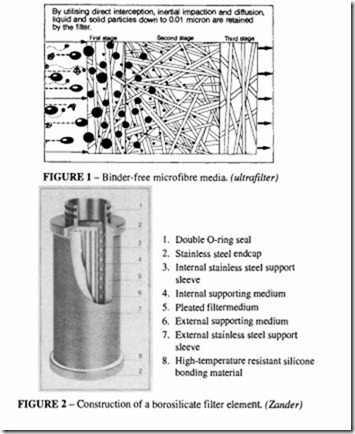STERILE AIR AND GAS FILTERS
The demand for sterile compressed air increases with the adoption of advanced technologies which were unknown a few years ago. The selection of a sterilization filter for a compressed air system can be a difficult task. The production of proteins, vaccines, antibodies, hormones, vitamins and enzymes involves high technology processes which require aseptic and sterile supplies of gases or liquids throughout the manufacturing cycle. The production and packaging of many dairy and food products such as beer, yoghurt, cream and cheese use compressed air or carbon dioxide. The nature of these products makes them susceptible to contamination by micro-organisms held in the compressed air or gas.
Any product that can be contaminated by airborne bacteria must be protected. In the case of food and chemicals produced by fermentation, bacteria would cause serious defects and rejection of the product.
In the fermentation and pharmaceutical industries, compressed air and other gases are used through every stage of the production process from the refining of the raw material to the manufacturing and packaging. Compressed air may be used as a source of energy in a process or as a biomedical aid. Air motors are used for explosion-free mixing of powders, instrumentation and cylinders for the hatching of materials.
Process air can be used for aeration of liquids, seed fermentation and laboratory applications. Mixing air into the preparatory chemicals or the final product means that they must be as clean and sterile as the material it serves, so there can be no risk of fouling by solids, liquids or micro-organisms.
Micro-organisms are extremely small and include bacteria, viruses, yeasts, fungus spores and bacteriophages. Bacteria can be from 0.2 micron to 4 micron, viruses less than micron and bacteriophages down to 0.04 micron. The filters that have to cope with these organisms have to have a performance rather better than these dimensions. The presence of these living organisms can be a serious problem in process industries, because they are able to multiply in the right conditions.
When selecting compressed air sterilization filters, the follow conditions must be satisfied:
• The filter must not allow penetration of any type of micro-organism that could cause contamination.
• It must be able to operate reliably for long periods.
• The materials of construction must be inert so as not to support biological growth.
It must be easy to install and maintain.
• It must be capable of being tested for integrity.
• It must be capable of being steam sterilized repeatedly.
• The filter must be as small as possible consistent with efficiency so as to reduce problems of installation.
Modern air sterilization filters use pleated hydrophobic binder-free borosilicate microfibres which have an efficiency of better than 99.9999% at 0.01 micron and remain in service for up to 12 months. The element has been constructed using an amalgamation of filter media (Figure I); the average diameter of the fibre is about 0.5 micron. The polluted air strikes the outer layer of relatively coarse medium (2 micron). This traps the dirt particles before it reaches the microfibre. The borosilicate collects the particles down to 0.01 micron. Any aerosols present are here converted into liquid. In removing micro-
organisms, three main mechanisms are present-direct interception, inertial impaction and Brownian motion. The second layerof2 micron medium is designed to hold the microfibre in place. These two media combined hold back the solid particles. In a dry air stream they will hold back bacteria. As long as the bacteria have no means of multiplying in the medium, they can be held. A filter medium containing a binder material which could act as a nutrient would be unsuitable. The complete construction can be seen in Figure 2.
Membrane cartridge filters are extremely flexible and high in tensile strength. Cartridge construction based on a multi-layercombination of filter media support an irrigation mesh. Nylon and polypropylene polymers that have previously been used in coarser grades are now used as membrane filters. Layers of nylon microporous membrane and polypropylene pre-filter are pleated together and supported by an inner core. The end caps are melt sealed in polypropylene. The membrane is of thin nylon having a controlled pore size. Its construction ensures that it cannot release fibres down stream; it can be repeatedly autoclaved.
